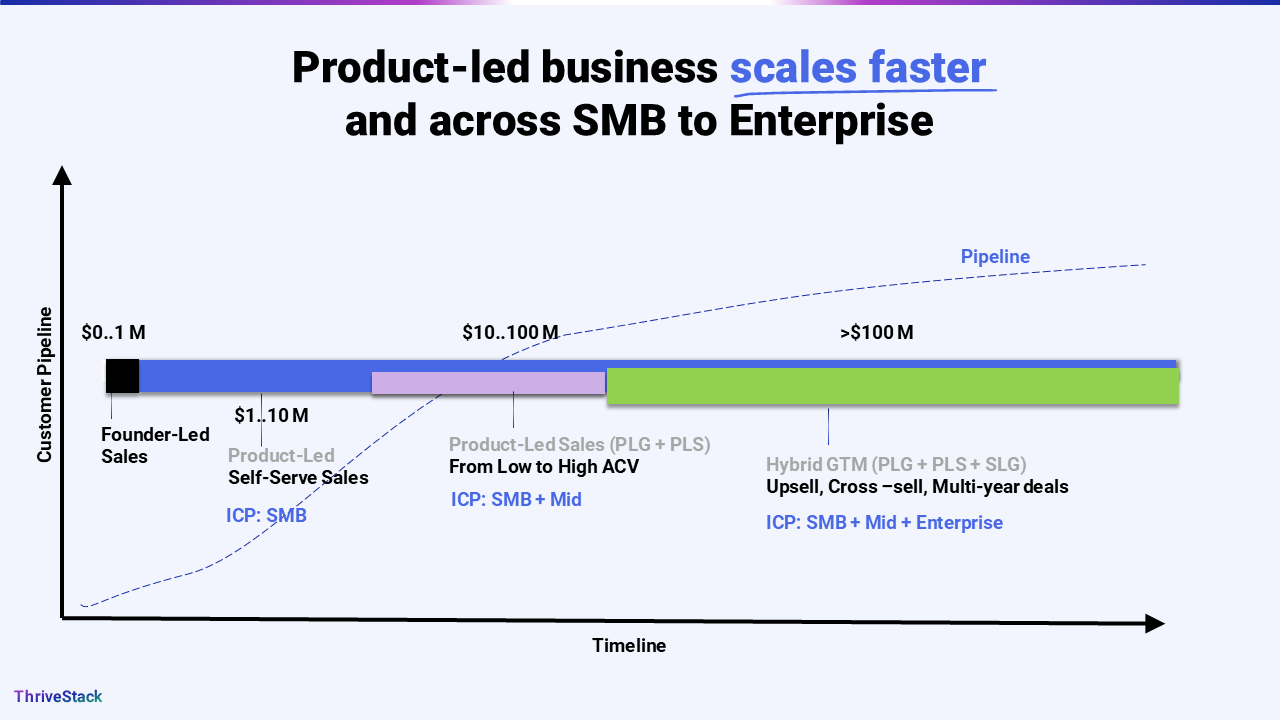Scaling a Product-Led business is easier than scaling Sales-Led business
Let's talk about efficient scaling for sustainable growth
PLG businesses scale faster, and it's easier to add SLG on top. But layering PLG onto a sales-led business? That’s almost improbable impossible.
This difference often is the deciding factor for scalable (sustainable) growth in the long term, and often drives companies to build go-to-market strategies that start with PLG to fuel growth, and then introduce sales.
Why Product-Led Growth Drives Faster and Sustainable Scaling?
Product-led businesses scale faster because the product (when done right) can drive user adoption, generate a pipeline, which are leading indicators of future revenue growth. From startups to enterprises, PLG based GTM allows companies to expand quickly across different markets without relying heavily on sales teams.
According to OpenView article that PLG business usually takes off after hitting $10M ARR, generating a healthy pipeline of customers all along the way. This pipeline growth is the key to sustainable, scalable growth.
As the company matures, layering in a targeted sales strategy becomes a way to complement the organic product growth, ensuring that both SMB and enterprise customers get the support they need. This approach strengthens the foundation built by PLG, allowing for a smoother transition into larger revenue streams.
The Struggles of Layering PLG on SLG
Sales-led companies rely on structured sales processes, which often conflict with the agility needed for PLG to thrive. This creates operational friction and cultural resistance, making it difficult to succeed.
Two major hurdles often become the deterrent
One major hurdle is the absence of PLG infrastructure. Sales-led organizations often lack the systems required for self-serve trials, product engagement tracking, and customer feedback loops—critical elements for driving PLG success.
And the entire Organization with all its departments firing on all cylinders contributing to the growth of the scalable business. Wes Bush calls this as Product-Led Organization. ThriveStack has interviewed and written extensively on this mindset shift e.g.
By addressing these foundational issues, companies can create the right conditions for successfully layering PLG on top of a sales-led strategy.
Why Product-Led Growth Outpaces Sales-Led Strategies
Scaling a Product-Led business is inherently easier because it leverages the Product to deliver the experiences, enabling faster time-to-value by simplifying product activation, — and when done right, will drive Customer acquisition costs (CAC) down, and deliver a lead pipeline for the Sales team to pursue larger, multi-year deal sizes.
Organization decisions would be informed by actual user behavior—how customers interact with the product. This data-driven approach ensures companies can scale efficiently without guesswork, optimizing product features and growth strategies based on real-time feedback.
In contrast, Sales-Led businesses tend to depend heavily on buyer intent— indirect signals from marketing, outreach, or customer interest—rather than direct insights from how users are engaging with the product. This disconnect creates inefficiencies, as sales teams focus on closing deals without fully understanding the product’s role in the customer’s decision-making process.
Product-Led Sales (PLS) bridges this gap by arming sales teams with crucial product data, enabling more effective targeting and better-timed outreach based on actual user interactions.
Key technical infrastructure challenges for PLG scaling:
Enabling product for self-serve: Allowing users to signup, try and potentially buy without (or less) sales interactions.
Tracking user engagement: PLG companies need robust systems to monitor how users interact with the product.
Integrating usage data with sales efforts: Ensuring that both teams have access to product usage insights to align strategies.
Shameless plug: ThriveStack provides the above 3.
Sales-Led companies often lack these essential infrastructure systems (alongside organizational buy-in and incentives), resulting in slower growth and more friction when transitioning to a PLG model.
“When a product shortens the buyer’s journey of discovering and experiencing value, it accelerates the purchase decision and establishes a strong foundation for growth.”
— ThriveStack
What do you think?








